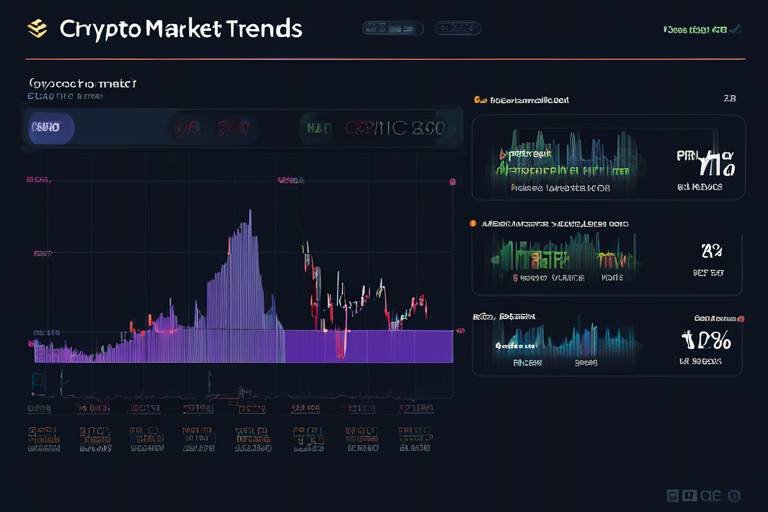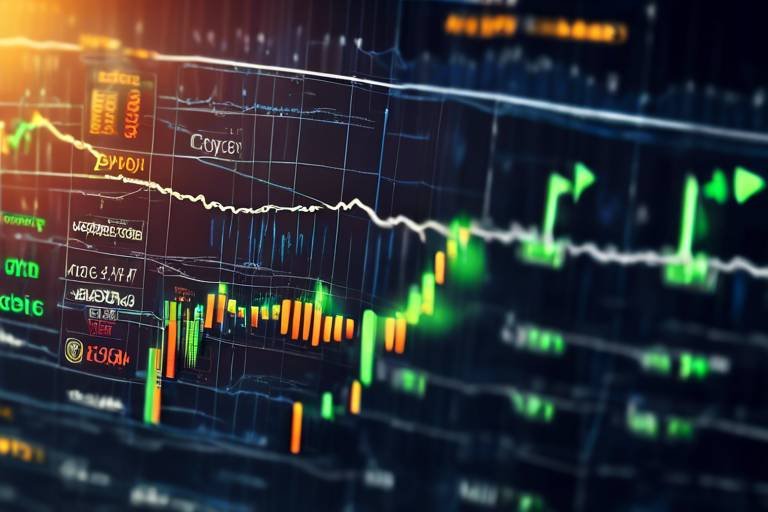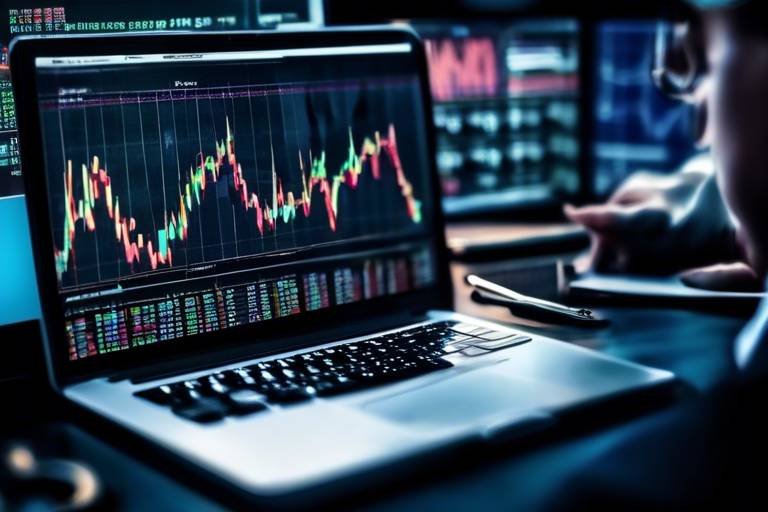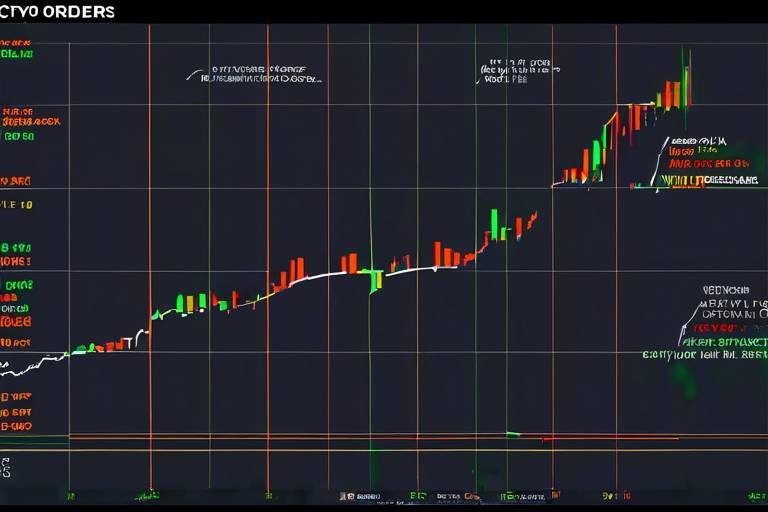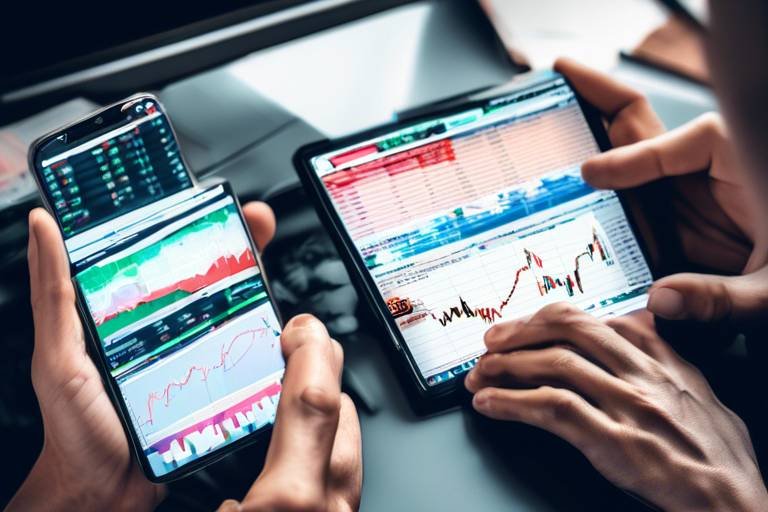How to Use Technical Analysis for Effective Crypto Trading
In the fast-paced world of cryptocurrency trading, making informed decisions can feel like navigating a maze blindfolded. That's where technical analysis comes into play, serving as your guiding light. By examining historical price movements and trading volumes, traders can forecast potential future market behavior. This article delves into the essential aspects of technical analysis, providing you with the tools and strategies needed to enhance your trading decisions and maximize your potential profits.
At its core, technical analysis is like reading the pulse of the market. It’s about understanding how past price movements can give us clues about future trends. Think of it as a detective story where every price chart tells a tale. By evaluating price patterns and trading volumes, you can uncover hidden insights that help you make better trading choices. In the world of crypto, where volatility reigns supreme, having a solid grasp of technical analysis is not just beneficial—it's essential.
When diving into technical analysis, you'll encounter a variety of indicators that can serve as your navigational tools. These indicators help you decode the market's behavior, revealing trends and potential entry or exit points. Some of the most popular indicators include:
- Moving Averages
- Relative Strength Index (RSI)
- Moving Average Convergence Divergence (MACD)
Each of these indicators has its unique strengths and can be combined to create a robust trading strategy. Let’s explore these indicators in more detail.
Moving averages are your best friends when it comes to identifying trends. They smooth out price data over a specific period, allowing you to see the bigger picture without getting lost in daily fluctuations. There are two primary types of moving averages:
The Simple Moving Average (SMA) is calculated by averaging a set number of past prices. For instance, a 50-day SMA takes the average of the last 50 days' closing prices. This indicator is particularly useful for spotting long-term trends, as it filters out the noise of short-term price movements. However, it can lag behind rapidly changing prices, making it essential to use in conjunction with other indicators.
On the other hand, the Exponential Moving Average (EMA) gives more weight to recent prices, making it more responsive to new information. This characteristic allows traders to react quickly to price changes, making the EMA a preferred choice for many day traders. By using both SMA and EMA together, you can create a more comprehensive view of market trends.
The Relative Strength Index (RSI) is another powerful tool in your trading arsenal. It measures the speed and change of price movements, helping traders identify overbought or oversold conditions. The RSI ranges from 0 to 100, with values above 70 indicating an overbought condition and values below 30 signaling that an asset may be oversold. By interpreting these values, you can make more informed decisions about when to enter or exit trades.
Recognizing chart patterns is vital for predicting future price movements. These patterns are like road signs that guide traders on their journey. Some common patterns include:
- Head and Shoulders
- Flags
- Triangles
Each of these patterns has its own significance and can indicate potential market reversals or continuations. Understanding these patterns can greatly enhance your trading strategy.
The head and shoulders pattern is a classic indicator of potential trend reversals. It consists of three peaks: a higher peak (the head) flanked by two lower peaks (the shoulders). When this pattern forms, it often signals that a bullish trend may be coming to an end, providing traders with a critical opportunity to reevaluate their positions.
Flags and pennants are continuation patterns that suggest a brief pause before the previous trend resumes. They look like small rectangles or triangles that form after a strong price movement. Identifying these patterns can help traders make strategic decisions about when to enter or exit trades, capitalizing on the momentum of the prevailing trend.
Integrating technical analysis into your trading strategies is like adding rocket fuel to your trading engine. It enhances your decision-making, allowing you to combine various indicators and patterns for effective trading. A solid trading plan should incorporate these insights, ensuring that you’re prepared for whatever the market throws your way.
A comprehensive trading plan outlines essential elements to consider, including your risk tolerance, target profit levels, and entry and exit strategies. By incorporating technical analysis insights, you can create a plan that not only guides your trading but also builds your confidence in your decisions.
Effective risk management is crucial in trading. Technical analysis can aid in setting stop-loss orders and managing capital, ensuring that you protect your investments while still capitalizing on potential gains. Remember, it’s not just about making profits; it’s about preserving your capital for the long haul.
Q: How can I start using technical analysis in my trading?
A: Begin by familiarizing yourself with key indicators like moving averages and RSI. Practice analyzing charts and patterns to develop your skills.
Q: Is technical analysis effective for all cryptocurrencies?
A: While technical analysis can be applied to most cryptocurrencies, its effectiveness may vary depending on market conditions and the specific asset.
Q: Can I rely solely on technical analysis for trading decisions?
A: It's best to combine technical analysis with fundamental analysis and market news to make well-rounded trading decisions.

Understanding Technical Analysis
Technical analysis is a fascinating approach that traders use to evaluate price movements and trading volumes in the cryptocurrency market. It’s like a crystal ball that helps predict future market behavior based on historical data. Imagine trying to navigate a stormy sea without a compass; that’s what trading without technical analysis feels like. By analyzing past price trends, traders can make educated guesses about where prices might head next. This method is especially significant in the highly volatile world of cryptocurrencies, where price swings can be as dramatic as a roller coaster ride.
At its core, technical analysis focuses on three main principles: price discounts everything, prices move in trends, and history tends to repeat itself. When we say that "price discounts everything," it means that all available information—economic, political, and even psychological factors—is reflected in the price. So, when you see a price change, it’s not just numbers; it’s a culmination of various factors influencing the market.
The second principle, that prices move in trends, is crucial. Think of it like riding a wave. If you can identify whether a wave is going up or down, you can choose to ride it to maximize your profits. In the crypto world, trends can be upward (bullish), downward (bearish), or sideways (range-bound). Understanding these trends can help traders make informed decisions about when to enter or exit a position.
Lastly, the idea that history tends to repeat itself is a fundamental concept in technical analysis. Patterns from the past often reappear, and savvy traders use this to their advantage. By studying historical price movements, traders can identify potential future movements. This is where chart patterns come into play, acting as visual cues that signal what might happen next.
To sum it up, technical analysis is not just about crunching numbers; it’s about understanding the market's psychology and making informed decisions. By leveraging various tools and indicators, traders can enhance their strategies and navigate the often unpredictable waters of cryptocurrency trading. So, whether you’re a seasoned pro or just dipping your toes into the crypto pool, mastering technical analysis can be a game-changer in your trading journey.

Key Indicators in Crypto Trading
When diving into the world of cryptocurrency trading, it's essential to equip yourself with the right tools to make informed decisions. One of the most powerful tools at your disposal is technical analysis, which relies heavily on key indicators. These indicators act like a compass, guiding traders through the unpredictable seas of the crypto market. Understanding how to read and interpret these indicators can significantly enhance your trading strategy and help you maximize profits.
Among the myriad of indicators available, a few stand out as particularly vital for crypto traders. Each of these indicators offers unique insights into market trends and price movements. Let's break down some of the most popular indicators that every crypto trader should know:
- Moving Averages: These indicators help smooth out price data over a specified period, making it easier to identify trends.
- Relative Strength Index (RSI): This momentum oscillator measures the speed and change of price movements, providing insights into overbought or oversold conditions.
- Moving Average Convergence Divergence (MACD): This trend-following momentum indicator shows the relationship between two moving averages of a security’s price, helping traders identify potential buy and sell signals.
Let’s take a closer look at each of these indicators, starting with Moving Averages.
Moving averages are fundamental tools in technical analysis, as they help traders identify the direction of the trend. They smooth out price data to create a single flowing line, which makes it easier to spot the overall direction of the market. There are two primary types of moving averages that traders commonly use: the Simple Moving Average (SMA) and the Exponential Moving Average (EMA).
The Simple Moving Average is calculated by averaging a set number of past prices. For example, a 10-day SMA is calculated by taking the average of the closing prices for the last ten days. This indicator is particularly useful for identifying longer-term trends. However, one drawback is that it can lag behind the price action, which might lead to missed opportunities.
In contrast, the Exponential Moving Average gives more weight to recent prices, making it more responsive to new information. This characteristic allows traders to react more quickly to price changes, which can be crucial in the fast-paced world of cryptocurrency trading. Many traders prefer the EMA for short-term trading strategies, as it can provide earlier signals for potential buy and sell opportunities.
The Relative Strength Index is another indispensable tool in a trader's arsenal. This momentum oscillator ranges from 0 to 100 and measures the speed and change of price movements. An RSI above 70 typically indicates that a cryptocurrency is overbought, while an RSI below 30 suggests it is oversold. Understanding these levels can help traders make more informed decisions about when to enter or exit a trade.
Incorporating these key indicators into your trading strategy can provide a significant edge. However, it's important to remember that no single indicator is foolproof. Instead, successful traders often combine multiple indicators to create a comprehensive trading strategy that suits their individual risk tolerance and trading style.
Q: What is the best indicator for crypto trading?
A: There isn't a one-size-fits-all answer, as the best indicator depends on your trading style. However, combining indicators like Moving Averages, RSI, and MACD can provide a well-rounded approach.
Q: How often should I check these indicators?
A: It depends on your trading strategy. Day traders might check indicators multiple times a day, while long-term investors might look at them weekly or monthly.
Q: Can I rely solely on technical indicators for trading?
A: While technical indicators are valuable, it's essential to consider other factors such as market news, fundamentals, and your own risk management strategies.

Moving Averages Explained
When it comes to technical analysis, moving averages are like the bread and butter of trading strategies. They help traders smooth out price fluctuations and identify the underlying trend direction, making them an essential tool in the crypto trader's toolkit. Think of moving averages as a way to filter out the "noise" of daily price movements, allowing you to see the bigger picture. By averaging a set number of past prices, traders can determine whether a cryptocurrency is in an uptrend, downtrend, or moving sideways.
There are two primary types of moving averages that traders often use: the Simple Moving Average (SMA) and the Exponential Moving Average (EMA). Each has its own unique characteristics and applications in trading. Let’s break them down:
| Type | Description | Use Case |
|---|---|---|
| Simple Moving Average (SMA) | Averages a set number of past prices. | Identifying long-term trends. |
| Exponential Moving Average (EMA) | Gives more weight to recent prices. | Reacting quickly to price changes. |
The Simple Moving Average (SMA) is calculated by taking the average of a specified number of past prices. For example, a 10-day SMA is calculated by adding the closing prices for the last ten days and dividing by ten. This method provides a clear view of the average price over that period, helping traders to see the overall trend. However, one downside is that it can lag behind current price movements, which might cause traders to miss out on timely entry or exit points.
On the other hand, the Exponential Moving Average (EMA) is a bit more dynamic. It gives more weight to the most recent prices, making it more responsive to sudden price changes. This characteristic can be incredibly advantageous for traders looking to capitalize on short-term price movements. For instance, if a cryptocurrency experiences a sudden spike in price, the EMA will react more quickly than the SMA, allowing traders to make faster decisions based on the latest market conditions.
When using moving averages in your trading strategy, it's crucial to consider the timeframes you want to analyze. Short-term moving averages (like the 5-day or 10-day) can help identify quick trades, while long-term moving averages (like the 50-day or 200-day) are better suited for spotting overall trends. By combining different moving averages, you can create a strategy that fits your trading style and objectives.
In summary, moving averages are powerful tools that can help you make informed trading decisions. Whether you prefer the straightforward approach of the SMA or the more responsive nature of the EMA, understanding how to use these indicators effectively can significantly enhance your trading strategy. So, the next time you look at a crypto chart, remember that moving averages can provide valuable insights into the market's behavior!

Simple Moving Average (SMA)
The is one of the most fundamental tools in technical analysis, especially in the realm of cryptocurrency trading. It provides traders with a clear view of the market's direction by averaging past prices over a specified period. This averaging process helps to smooth out price fluctuations and reduces the noise that can often lead to misleading signals. Imagine trying to see the forest for the trees; the SMA allows you to step back and observe the broader trends without getting lost in the daily price chaos.
To calculate the SMA, you simply add up the closing prices of a cryptocurrency over a predetermined number of periods and then divide that sum by the number of periods. For instance, if you wanted to calculate a 5-day SMA, you would add the closing prices of the last five days and divide by five. The formula looks like this:
SMA (P1 + P2 + P3 + P4 + P5) / 5
Where P1, P2, P3, P4, and P5 are the closing prices for each of the last five days. This calculation gives you a single average price that can be plotted on a chart, providing a visual representation of the trend.
One of the most appealing aspects of the SMA is its simplicity. However, this simplicity can also be a double-edged sword. While it effectively identifies trends, it may lag behind the price action, especially in volatile markets like cryptocurrencies. This lag can sometimes lead traders to miss out on potential entry or exit points. To mitigate this issue, many traders use the SMA in conjunction with other indicators or shorter-term moving averages to create a more comprehensive trading strategy.
Here are a few key points to keep in mind when using the SMA:
- Trend Identification: An upward SMA indicates a bullish trend, while a downward SMA suggests a bearish trend.
- Support and Resistance Levels: SMA lines can act as dynamic support or resistance levels. When the price approaches the SMA, it may bounce off or break through.
- Crossovers: When a shorter-term SMA crosses above a longer-term SMA, it can signal a buying opportunity, known as a "golden cross." Conversely, a crossover below can indicate a selling opportunity, known as a "death cross."
In conclusion, the Simple Moving Average is a powerful yet straightforward tool that can enhance your trading decisions. By understanding how to calculate and interpret the SMA, you can better navigate the often turbulent waters of crypto trading. Remember, though, that no single indicator is foolproof. Combining the SMA with other technical analysis tools will provide you with a more robust trading strategy.

Exponential Moving Average (EMA)
The is a powerful tool in the arsenal of any crypto trader, providing a more dynamic view of price trends compared to its counterpart, the Simple Moving Average (SMA). What sets the EMA apart is its ability to give greater weight to the most recent price data, making it particularly responsive to price changes. This characteristic allows traders to identify trends more quickly, which is crucial in the fast-paced world of cryptocurrency trading.
When you look at price charts, the EMA appears smoother than the SMA, which can help traders spot potential entry and exit points more effectively. For instance, if you notice the EMA line crossing above the price line, it might indicate a good buying opportunity. Conversely, if the EMA dips below the price line, it could serve as a signal to sell. This responsiveness can be likened to a sports car that accelerates faster than a standard vehicle, allowing you to make quicker decisions in the market.
To calculate the EMA, you need to follow a specific formula that factors in the previous EMA value and the current price. The formula is as follows:
EMA (Current Price x K) + (Previous EMA x (1 - K)) where K 2 / (N + 1)
In this formula, N represents the number of periods over which you want to calculate the EMA. For example, a 10-day EMA would use 10 as the value for N. The resulting value of K will determine how much weight is given to the most recent price. The smaller the N, the more sensitive the EMA will be to price changes.
Many traders use the EMA in conjunction with other indicators to enhance their trading strategies. For instance, combining the EMA with the Relative Strength Index (RSI) can provide a more comprehensive view of market conditions, helping to determine whether a cryptocurrency is overbought or oversold. This combination can be particularly effective, as it allows traders to make informed decisions based on both trend direction and momentum.
In summary, the EMA is not just a number on a chart; it’s a vital piece of the puzzle that can help traders navigate the often tumultuous waters of cryptocurrency trading. By understanding how to calculate and interpret the EMA, traders can position themselves to take advantage of market movements, enhancing their potential for profit.

Relative Strength Index (RSI)
The is a powerful momentum oscillator that helps traders evaluate the speed and change of price movements. It operates on a scale from 0 to 100, providing valuable insights into whether a cryptocurrency is overbought or oversold. Typically, an RSI value above 70 indicates that an asset may be overbought, suggesting a potential price correction, while an RSI below 30 signals that it may be oversold, hinting at a possible price increase. Understanding how to interpret these values can significantly enhance your trading strategy.
To calculate the RSI, you first need to determine the average gains and average losses over a specific period, usually 14 days. The formula for calculating the RSI is as follows:
RSI 100 - (100 / (1 + RS)) where RS Average Gain / Average Loss
This formula may seem complex at first, but once you grasp the concept, it becomes an invaluable tool in your trading arsenal. The RSI not only helps you identify potential entry and exit points but also assists in confirming trends. For instance, if the price is rising but the RSI is falling, it may indicate a weakening trend, prompting you to reconsider your position.
Moreover, the RSI can be used in conjunction with other indicators to create a more robust trading strategy. For example, pairing the RSI with Moving Averages can provide clearer signals. When the RSI indicates an overbought condition while the price is above a moving average, it might suggest a stronger case for a potential downturn.
It's also worth noting that the RSI can exhibit divergences. A bullish divergence occurs when the price makes a new low while the RSI forms higher lows, suggesting that a reversal might be on the horizon. Conversely, a bearish divergence happens when the price reaches a new high but the RSI creates lower highs, indicating potential weakness in the upward trend.
To summarize, the RSI is a versatile tool that can provide critical insights into market conditions. By understanding how to read and interpret its signals, you can make more informed trading decisions, ultimately enhancing your chances of success in the volatile world of cryptocurrency trading.
- What is the best period for calculating RSI? The most commonly used period is 14 days, but traders can adjust this based on their trading style.
- Can RSI be used for all cryptocurrencies? Yes, RSI is applicable to any asset with price movements, including stocks and commodities.
- How do I combine RSI with other indicators? Pairing RSI with Moving Averages or MACD can help confirm trends and provide clearer signals.

Chart Patterns and Their Importance
When it comes to cryptocurrency trading, chart patterns serve as a crucial compass, guiding traders through the often tumultuous waters of price fluctuations. These patterns are like the footprints of a market’s past, revealing the psychology of traders and hinting at potential future movements. By recognizing these formations, traders can make informed decisions, whether they're looking to enter or exit a position. But why are these patterns so significant? Well, they provide insights into market sentiment and can signal potential reversals or continuations, which are essential for crafting effective trading strategies.
Chart patterns can be broadly categorized into two types: continuation patterns and reversal patterns. Continuation patterns suggest that the current trend will persist, while reversal patterns indicate a potential shift in direction. Understanding these distinctions is vital for any trader aiming to maximize their profits and minimize risks. For instance, when a trader identifies a continuation pattern, they can confidently ride the trend, whereas recognizing a reversal pattern might prompt them to reconsider their position.
Some of the most common chart patterns include:
- Head and Shoulders: Often viewed as one of the most reliable reversal patterns, the head and shoulders pattern signals a potential change from bullish to bearish trends.
- Flags and Pennants: These patterns typically indicate a brief pause in the market before the previous trend resumes, allowing traders to capitalize on the continuation.
- Triangles: Triangles can be ascending, descending, or symmetrical, and they often suggest a breakout in either direction, depending on the market’s momentum.
Let’s take a closer look at the Head and Shoulders pattern. This formation consists of three peaks: the first peak (left shoulder), a higher peak (head), and a third peak (right shoulder) that is lower than the head. This pattern suggests that the current trend is losing momentum, and a bearish reversal may be on the horizon. Traders often look for confirmation through volume trends and other indicators before acting on this pattern.
On the flip side, Flags and Pennants are continuation patterns that emerge after a strong price movement. A flag resembles a rectangle that slopes against the prevailing trend, while a pennant looks like a small symmetrical triangle. Both patterns indicate a brief consolidation period before the price resumes its original direction. The beauty of these patterns lies in their ability to offer traders a chance to enter a position at a lower risk point, right before the trend picks up steam again.
Incorporating chart patterns into your trading strategy is not just about recognition; it’s about timing and execution. Understanding when to enter and exit based on these patterns can make a significant difference in your trading outcomes. For example, a trader might decide to enter a long position when a bullish flag pattern is confirmed by a breakout above resistance. Conversely, they may choose to set a stop-loss order just below the support level to protect their capital in case the market moves against them.
In conclusion, chart patterns are more than just shapes on a graph; they are powerful tools that reflect market psychology and can lead to profitable trading decisions. By mastering these patterns and integrating them into your overall trading strategy, you can enhance your ability to navigate the unpredictable world of cryptocurrency trading.

Head and Shoulders Pattern
The is one of the most recognized and reliable indicators in technical analysis. It serves as a powerful signal for traders looking to identify potential trend reversals. Imagine standing at the edge of a cliff, peering down at the vast, unpredictable ocean below. Just as the waves can indicate a storm or calm waters, the Head and Shoulders pattern can forecast a significant shift in market sentiment. This pattern typically forms after an uptrend, signaling that a bearish reversal may be on the horizon.
At its core, the Head and Shoulders pattern consists of three peaks: two shoulders and a head. The left shoulder forms first, followed by a higher peak, which is the head, and then a right shoulder that is lower than the head but similar in height to the left shoulder. To visualize this:
| Peak | Position |
|---|---|
| Left Shoulder | First peak |
| Head | Highest peak |
| Right Shoulder | Second peak |
To confirm the formation of a Head and Shoulders pattern, traders often look for a neckline, which is drawn by connecting the lowest points of the two troughs that sit between the shoulders. When the price action breaks below this neckline, it serves as a strong confirmation that the uptrend is reversing, similar to a light switch being flipped from 'on' to 'off'. This break can be a critical moment for traders, indicating that it might be time to enter a short position.
However, it's essential to remember that not every Head and Shoulders pattern will lead to a successful trade. Just like weather forecasts, technical analysis can provide insights, but it’s not foolproof. Traders should consider additional factors, such as volume and other indicators, to enhance their decision-making process. For instance, a higher trading volume during the breakout below the neckline can add further confirmation to the pattern, making it more reliable.
In summary, the Head and Shoulders pattern is a vital tool in a trader's arsenal. By understanding its formation and implications, traders can better navigate the turbulent waters of cryptocurrency markets. It’s not just about recognizing the pattern; it's about interpreting it correctly and integrating it into a broader trading strategy that includes risk management and market analysis.
- What does the Head and Shoulders pattern indicate? It indicates a potential reversal in the market trend from bullish to bearish.
- How can I identify a Head and Shoulders pattern? Look for three peaks: a left shoulder, a head, and a right shoulder, along with a neckline connecting the troughs.
- Is the Head and Shoulders pattern always reliable? No, while it's a strong indicator, it should be used in conjunction with other analysis tools for better accuracy.

Flags and Pennants
When it comes to technical analysis in crypto trading, are two of the most exciting chart patterns that traders love to watch. They are often seen as a signal that the previous trend is about to continue, which can be quite thrilling, right? Imagine you're on a roller coaster, and just before the big drop, you get that moment of anticipation. That's what flags and pennants can feel like in the trading world!
So, what exactly are these patterns? Both flags and pennants form after a strong price movement, typically characterized by a sharp price increase or decrease, followed by a period of consolidation. This consolidation happens in a smaller price range, creating a visual representation that looks like a flag on a flagpole or a pennant in a triangular shape. Understanding these patterns can give you a significant edge in your trading strategy.
Flags are rectangular-shaped patterns that slope against the prevailing trend. For example, if the price has been moving upwards, the flag will slope downwards. They usually last for a short period, ranging from a few days to a couple of weeks. Traders often look for a breakout from the flag pattern, which typically indicates a continuation of the previous trend. On the other hand, pennants are more triangular in shape and are formed when the price consolidates after a strong movement. They have converging trend lines, which means the price is getting squeezed into a smaller range, leading to a breakout either upwards or downwards.
To help visualize these patterns, let's look at a simple representation:
| Pattern Type | Shape | Duration | Market Behavior |
|---|---|---|---|
| Flag | Rectangular | Days to Weeks | Continuation of the trend |
| Pennant | Triangular | Days to Weeks | Continuation of the trend |
Trading flags and pennants involves a keen eye for detail and a solid understanding of market psychology. When you spot one of these patterns, it's essential to wait for a breakout. This means that you should look for the price to move beyond the boundaries of the flag or pennant before making your move. A breakout accompanied by increased volume often confirms the pattern, signaling a strong continuation of the trend. However, as with any trading strategy, it's crucial to implement proper risk management techniques to protect your capital.
In summary, flags and pennants are not just random patterns; they are powerful indicators that can help you make informed trading decisions. By recognizing these formations and understanding their implications, you can enhance your trading strategy and potentially increase your profits. So, the next time you're analyzing a crypto chart, keep an eye out for these exciting patterns!
- What are flags and pennants in trading? Flags and pennants are chart patterns that indicate a continuation of the previous trend after a period of consolidation.
- How do I identify a flag or pennant pattern? Look for a strong price movement followed by a consolidation phase that forms either a rectangular shape (flag) or a triangular shape (pennant).
- What should I do when I spot a flag or pennant? Wait for a breakout above or below the pattern, ideally accompanied by increased trading volume, before entering a trade.

Implementing Technical Analysis in Trading Strategies
Integrating technical analysis into your trading strategies can feel like unlocking a treasure chest of insights. Imagine being able to predict the tides of the market with a reliable compass! By understanding how to effectively use various technical indicators and chart patterns, you can enhance your decision-making process, minimize risks, and maximize your potential profits. So, how do you weave these elements into a cohesive strategy?
First and foremost, it's essential to create a solid trading plan that incorporates the insights gained from technical analysis. Think of your trading plan as a roadmap guiding you through the often turbulent waters of cryptocurrency trading. A well-structured plan should include:
- Entry and Exit Points: Determine your buy and sell points based on signals from indicators like Moving Averages and RSI.
- Risk Management: Set clear rules for how much capital you are willing to risk on each trade.
- Timeframes: Decide on the timeframes that suit your trading style, whether day trading, swing trading, or long-term investing.
Next, let’s talk about the importance of combining multiple indicators. Relying on a single indicator can sometimes lead to misleading signals. Instead, using a combination can provide a clearer picture. For instance, pairing the Relative Strength Index (RSI) with Moving Averages can help confirm trends and identify potential reversals. When the RSI indicates an overbought condition while the price is above the Moving Average, it might signal a good time to sell.
Additionally, understanding market sentiment is crucial. Technical analysis isn't just about numbers; it's also about psychology. By keeping an eye on volume trends and market news, you can gauge how other traders might react, allowing you to make more informed decisions. For example, if you notice a spike in trading volume coinciding with a bullish chart pattern, that could be a strong signal to enter a trade.
Another vital aspect of implementing technical analysis is risk management. No one likes to talk about losses, but the reality is that they are part of trading. A good trader knows how to manage these risks effectively. Set stop-loss orders based on your analysis to protect your capital. For instance, if you enter a trade based on a bullish pattern but the market moves against you, a well-placed stop-loss can minimize your losses and keep your trading account healthy.
In summary, implementing technical analysis in your trading strategies isn't just about crunching numbers; it's about creating a dynamic approach that evolves with the market. By incorporating multiple indicators, understanding market sentiment, and employing robust risk management techniques, you can navigate the volatile world of cryptocurrency trading with greater confidence and success.
Q: What is the best technical indicator for crypto trading?
A: There isn't a one-size-fits-all answer. Popular indicators like Moving Averages, RSI, and MACD each serve different purposes, so it's best to use a combination based on your trading style.
Q: How do I know when to enter or exit a trade?
A: Look for signals from your chosen indicators. For example, if the RSI indicates overbought conditions and the price is nearing a resistance level, it might be a good time to consider selling.
Q: Can technical analysis guarantee profits?
A: While technical analysis can enhance your trading decisions, it does not guarantee profits. Always be prepared for market volatility and have a risk management strategy in place.

Creating a Trading Plan
Creating a robust trading plan is like building the foundation of a house; without it, everything else is likely to collapse. A well-structured trading plan not only guides your decisions but also helps you manage your emotions during the ups and downs of crypto trading. So, what should you include in your trading plan to ensure it stands the test of time?
First and foremost, you need to define your trading goals. Are you looking for short-term gains, or are you in it for the long haul? Establishing clear objectives will help you stay focused and not get swayed by market noise. For example, if your goal is to achieve a 20% return within six months, your strategy will differ significantly from someone aiming for a 100% return over two years.
Next, consider your risk tolerance. This is crucial because it determines how much capital you're willing to risk on each trade. A common approach is to risk only 1-2% of your trading capital on a single trade. This way, even a series of losses won't wipe you out. Here’s a simple breakdown:
| Risk Level | % of Capital per Trade |
|---|---|
| Low | 1% |
| Moderate | 1.5% |
| High | 2% |
After defining your goals and risk tolerance, it’s time to select the trading strategies you will employ. Will you be using technical analysis, fundamental analysis, or a combination of both? Decide on the indicators and chart patterns that resonate with your trading style. For instance, if you prefer a more hands-on approach, you might lean towards day trading, while others might find success with swing trading or even long-term investing.
Additionally, it’s vital to develop a trade management strategy. This includes setting entry and exit points, as well as stop-loss orders. A well-defined exit strategy can prevent emotional decision-making when the market turns against you. For example, if you set a stop-loss at 5% below your entry price, you can minimize potential losses and protect your capital.
Lastly, don't forget to incorporate a review process into your trading plan. Regularly analyzing your trades—both winners and losers—will provide valuable insights into what works and what doesn’t. This self-reflection is essential for continuous improvement and will help you adapt your strategies over time.
In conclusion, a well-crafted trading plan is your roadmap to success in the volatile world of crypto trading. By setting clear goals, understanding your risk tolerance, choosing effective strategies, managing your trades, and reviewing your performance, you’ll be better equipped to navigate the ups and downs of the market with confidence.
- What is the importance of a trading plan? A trading plan provides structure and direction, helping traders make informed decisions and manage emotions.
- How often should I review my trading plan? Regular reviews—monthly or quarterly—can help you adapt to market changes and improve your strategies.
- Can I change my trading plan? Yes, your trading plan should evolve based on your experiences, market conditions, and personal goals.

Risk Management Techniques
When diving into the world of crypto trading, it's crucial to remember that while the potential for profit can be exhilarating, the risks can be just as significant. This is where come into play. Think of your trading strategy as a ship navigating through unpredictable waters; without a solid plan to handle rough seas, you're bound to capsize. So, how can you ensure that your trading journey remains as smooth as possible?
First and foremost, one of the most effective risk management techniques is setting stop-loss orders. A stop-loss order is like a safety net that automatically sells your asset when it reaches a predetermined price. This prevents you from losing more than you can afford. For example, if you purchase Bitcoin at $50,000 and set a stop-loss at $48,000, your investment will automatically sell if the price drops to that level, limiting your loss to just $2,000. This is a fundamental strategy that every trader should embrace.
Another essential technique is to determine your risk-reward ratio. This ratio helps you evaluate the potential profit of a trade against the potential loss. A commonly used ratio is 1:3, meaning for every $1 you risk, you aim to make $3. This approach not only helps in assessing the viability of a trade but also encourages disciplined trading practices. To illustrate, if you risk $100 on a trade, you should aim to make at least $300. This way, even if you lose a few trades, your profitable trades can still keep you afloat.
Moreover, diversifying your portfolio is another powerful risk management technique. Just like you wouldn't put all your eggs in one basket, you shouldn't invest all your capital in a single cryptocurrency. By spreading your investments across various assets, you minimize the impact of a poor-performing asset on your overall portfolio. For instance, consider allocating your funds among Bitcoin, Ethereum, and some altcoins. This way, if one asset underperforms, the others may compensate, safeguarding your investment.
Lastly, always keep an eye on your trading psychology. Emotional trading can lead to impulsive decisions that jeopardize your capital. Techniques such as keeping a trading journal can help you reflect on your trades and understand your emotional triggers. By identifying patterns in your behavior, you can develop a more disciplined approach to trading, ensuring that your decisions are based on analysis rather than emotions.
In summary, effective risk management techniques are essential for navigating the volatile world of crypto trading. By implementing strategies such as stop-loss orders, determining risk-reward ratios, diversifying your portfolio, and managing your trading psychology, you can enhance your trading experience and improve your chances of long-term success.
- What is a stop-loss order? A stop-loss order is an instruction to sell an asset when it reaches a certain price, helping to limit potential losses.
- How do I determine my risk-reward ratio? The risk-reward ratio compares the potential profit of a trade to the potential loss, helping traders make informed decisions.
- Why is diversification important in crypto trading? Diversification helps mitigate risk by spreading investments across multiple assets, reducing the impact of any single asset's poor performance.
- How can I manage my trading psychology? Keeping a trading journal and reflecting on your trades can help you identify emotional triggers and develop a more disciplined trading approach.
Frequently Asked Questions
- What is technical analysis in crypto trading?
Technical analysis is a method used by traders to evaluate and predict future price movements in cryptocurrency markets. By analyzing past price data and trading volumes, traders can identify trends, patterns, and potential market reversals, helping them make informed trading decisions.
- How do I use moving averages in my trading strategy?
Moving averages are powerful tools for identifying trends. You can use the Simple Moving Average (SMA) to smooth out price data over a set period, while the Exponential Moving Average (EMA) reacts more quickly to recent price changes. By observing crossovers between different moving averages, traders can spot potential buy or sell signals.
- What does the Relative Strength Index (RSI) indicate?
The RSI is a momentum oscillator that measures the speed and change of price movements. It ranges from 0 to 100 and helps traders identify overbought or oversold conditions. An RSI above 70 typically indicates an overbought market, while an RSI below 30 suggests an oversold market, signaling potential trading opportunities.
- Why are chart patterns important in crypto trading?
Chart patterns are essential because they help traders predict future price movements based on historical data. Recognizing patterns like head and shoulders, flags, and triangles can provide insights into potential trend reversals or continuations, allowing traders to make better decisions about when to enter or exit positions.
- How can I create a solid trading plan?
A solid trading plan should incorporate technical analysis insights, including the use of indicators and chart patterns. It should outline your trading goals, risk tolerance, entry and exit strategies, and the specific indicators you plan to use. This structured approach can help you stay disciplined and focused in your trading activities.
- What risk management techniques should I consider?
Effective risk management is crucial in trading to protect your capital. Techniques include setting stop-loss orders based on technical analysis, diversifying your portfolio, and only risking a small percentage of your capital on each trade. By managing risk properly, you can minimize losses and increase your chances of long-term success.





